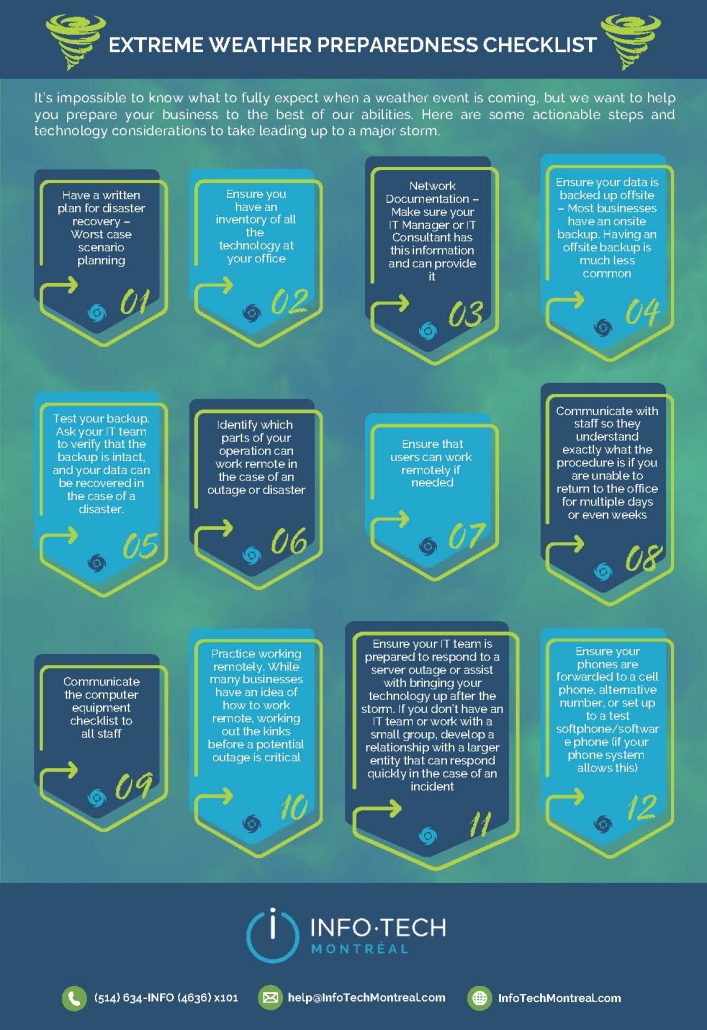IT Preparedness in the Face of Floods and Fires

Living in Ontario and Quebec offers us rich cultural experiences and promising economic opportunities. However, as the recent warmest summer on record has shown us, these provinces are not immune to the challenges created by climate change.
Floods and fires, caused by global warming, have become more common nowadays. As many businesses rely more and more on technology, the impact of these disasters can affect whole industries. We are going to discuss crucial tech aspects to ensure your business continues to function during these events.
The Need to Adapt: Floods and Fires in Perspective
The increasing frequency of floods and fires across the country is not a coincidence. They serve as examples of the tangible impacts of global warming. Both of these (and other weather events) pose a similar set of challenges for IT infrastructure:
- Potential physical damage to on-premise servers and equipment.
- Connectivity disruptions due to infrastructure damages.
- Immediate shift to remote working to ensure business continuity.
Steps for Business Preparedness: Pre-event Checklist Questions to Ask Yourself
It’s important to know where your data and operations are mainly stored – either in the cloud, or on-premise. The answer to this can have significant implications during adverse weather events or other disruptions:
- Email: Is your email system hosted externally on a cloud platform, or is it run from a server within your premises? When disruptions happen, cloud-based systems often offer more flexibility and accessibility.
- Line of Business Applications: These are the core software applications that your business operations rely on. Are they cloud-hosted, allowing for remote access anytime, anywhere, or are they tethered to a specific location?
- Shared Data: Where is your collaborative data stored? On local servers or cloud-based platforms like Google Drive, Dropbox, or Microsoft OneDrive? If your local systems fail, cloud storage can still keep your data safe and accessible.
- Remote Working Capability (Team Collaboration): Can your teams pivot to a remote work environment without hiccups? Team collaboration tools are Microsoft Teams, Slack, etc. Working remotely plays an important role in our unpredictable world today. Not only is it about the software but it is also about ensuring employees are trained and equipped. Being able to easily transition to remote work can help keep a business going in any situation.
- Remote desktop connectivity (SSL VPN): Do you have secure VPN connections with sufficient licenses which can handle this load?
- Phone Systems: Do you have a traditional phone system that is stable and well-known, or do you use VoIP, which offers flexibility and often cost savings? Consider what best suits your business needs.
- Microsoft Gateway Service: Is this something that you have? Think of Microsoft Gateway Service as a translator for your various business tools, ensuring they all communicate smoothly with each other. It streamlines operations.
- Physical Server Safety (For those not already in cloud setups): Is your physical serveraccessible during disasters? Do you have protective measures against potential damages (water and fire-resistant setups)?
- Connectivity Assurances: Are there any secure alternatives for internet connectivity so your business can stay online during infrastructure damages?
Proactive Measures for Weather Events
Just as we prepare our homes for floods and fires, our business’s IT setups also need preparation. Here are some steps to take:
- Develop a comprehensive disaster recovery plan.
- Maintain an updated inventory of all tech resources.
- Ensure regular offsite backups and routinely test their effectiveness.
- Practice remote working scenarios to iron out issues in real-time.
- Collaborate closely with your IT teams for rapid responses during emergencies.
- Forward phones to alternate numbers or softphone solutions to ensure communication lines remain open.
IT Resilience Amidst Climate Challenges
The climate in Canada is changing, we’ve seen that first hand with the warmest summer on record and increasing extreme weather events. This means businesses in Ontario and Quebec must be more proactive. By ensuring that our IT infrastructure is robust and disaster-ready, we can reduce the impact of storms, floods, fires, or any other weather events of the future.
Before entering the ice and snowstorm season, it’s important to get ready and plan for the problems they might cause. Don’t wait for the next disaster – contact our IT company today to safeguard your business technology against the unpredictable forces of nature.




